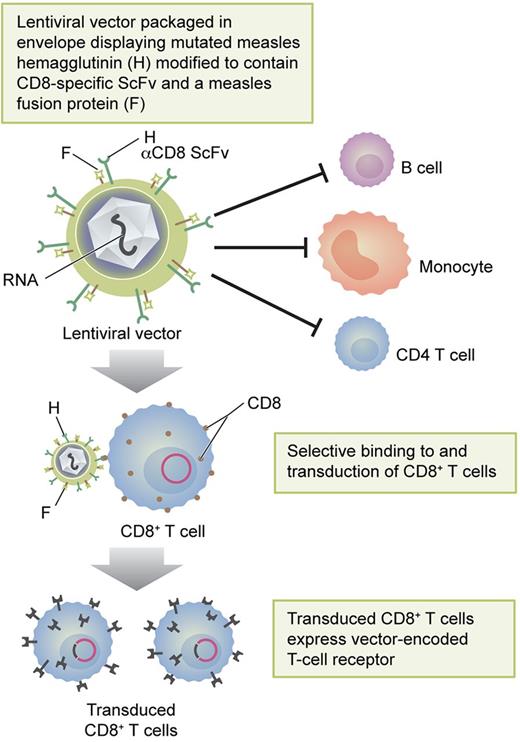In this issue of Blood, Zhou et al describe a strategy for modifying the envelope proteins of a lentiviral vector to display a single chain antibody fragment, or ScFv, specific for CD8 so that the lentiviral vector selectively binds to and transduces CD8+ T lymphocytes.1
Retroviral and lentiviral vectors have been extensively used for genetic modification of cells in vitro and in vivo due to the efficiency with which they can transduce and integrate genes into a broad array of human cell types. Until recently, strategies to insure that transduced genes are expressed only in specific cell lineages or types have been largely based on transcriptional targeting, or the incorporation of promoters controlling expression of the transduced gene that are only activated in specific cell lineages at defined stages of differentiation.2,3 Attempts to selectively transduce specific types of cells have largely focused on isolation of those cells before exposure to the vector. This can be performed in vitro with certain types of human cells with significant efficiency and selectivity. For example, retroviral vectors selectively transduce nonspecifically activated or antigen sensitized T cells as they proliferate.4,5 Alternatively, lentiviral vectors can be used to transduce isolated lymphocyte populations irrespective of their stage in the cell cycle.6 However, for other, rarer cell types, such as primitive hematopoietic stem cells with potential for self-renewal, even lentiviruses have exhibited more limited efficiency.7 Furthermore, methods for selectively transducing functional subsets of differentiated cells such as lymphocytes, monocytes, or parenchymal cells of different organs in vivo have been lacking.
Currently, most lentiviral vectors used for genetic modification of human cells are packaged or pseudotyped in an envelope protein derived from vesicular stomatitis virus (VSV) that is able to bind to and facilitate entry into a broad array of human cells. In the approach described by Zhou et al, lentiviral vectors encoding T-cell receptors (TCRs) specific for a tyrosinase peptide epitope presented by HLA A0201 were generated and packaged in viral particles with envelopes displaying both a truncated measles virus fusion protein and a measles virus hemagglutinin that has been mutated so as to be unable to bind to its 2 natural viral receptors, CD46 and SLAM, and further modified to contain in its ectodomain an ScFv specific for CD8 (see figure).1 In vitro, these CD8-ScFv–displaying lentiviral vectors selectively transduce human CD8+ T cells and express the vector-encoded TCRs. Furthermore, CD8 T cells transduced with this vector exhibited specific and higher than expected cytolytic activity against cells bearing the targeted epitope and HLA A0201. In contrast, the same vectors packaged with VSV or nonmutated measles envelope proteins transduced both CD8+ and CD8− T cells. Strikingly, the CD8-ScFv–expressing lentiviral vector particles were also able to selectively transduce human CD8+ T cells when administered intraperitoneally into NOD-Scid-IL-2rynull (NSG) mice 1 week after the mice had received an intraperitoneal injection of human PBMCs.
Envelope modification for selective transduction of CD8+ T cells with lentiviral vectors. Professional illustration by Kenneth X. Probst.
Envelope modification for selective transduction of CD8+ T cells with lentiviral vectors. Professional illustration by Kenneth X. Probst.
Prior studies from this group, led by Buchholz, have shown that similarly modified lentiviral vectors displaying ScFvs specific for human CD20, CD105, or CD133 can selectively transduce in vitro CD20+ B cells, CD105+ endothelial cells, or CD133+ hematopoietic progenitor cells at high efficiency even when these cells constitute only minor fractions of unstimulated or cytokine-mobilized PBMCs.8,9 They also showed that a vector bearing ScFvs specific for the AMPA glutamate receptor subunits GluA2 and GluA4 in mice would selectively transduce murine neuronal cells both in vitro and when injected into the hippocampus of mice in vivo.8 The current study is a further advance, demonstrating not only the striking selectivity and transduction efficiency of the CD8-targeted vectors in vitro but also their capacity to selectively transduce widely distributed human CD8+ T cells in vivo.
Immunologically retargeted lentiviral vectors capable of efficiently and selectively transducing specific functional classes of differentiated human lymphocytes could have important therapeutic applications. Two potential extensions of the current work can be immediately envisioned. For the immunocompromised cancer patient or transplant recipient with a drug-resistant or otherwise untreatable life-threatening viral infection, in vitro or, particularly, in vivo transduction of CD8+ T cells to express TCRs specific for epitopes of critical viral proteins known to be presented by 1 or more HLA alleles of the patient, could induce rapid development of meaningful resistance. Similarly, CD8-targeted lentiviral vectors encoding high-affinity TCRs or chimeric antigen receptors specific for uniquely or differentially expressed tumor antigens could greatly expedite selective expansion of cytolytic effector T-cell populations in vitro for adoptive therapy. Alternatively, injection of such vectors into draining lymph nodes could foster selective expansions of CD8+ effector T cells expressing the tumor-specific TCRs or chimeric antigen receptors (CARs) both locally and systemically.
Over the past decade, progress in the development of safe vectors for efficient transduction and durable modification of human T cells to express vector-encoded TCRs or CARs specific for tumors or exogenous pathogens as well as genes augmenting, sustaining, or modulating their activity has been extraordinary. Many of these advances are now being tested in clinical trials evaluating immune cells modified with such vectors in vitro. The development of vectors such as described by Zhou et al that can selectively target and efficiently transduce functional subsets of immune cells, in vitro, should facilitate analyses of their respective contributions to short- and long-term immunity, after adoptive transfer. In addition, such vectors may open a therapeutic window to direct modification of the specificity and function of immune cells in vivo.
Conflict-of-interest disclosure: The author declares no competing financial interests. ■


This feature is available to Subscribers Only
Sign In or Create an Account Close Modal